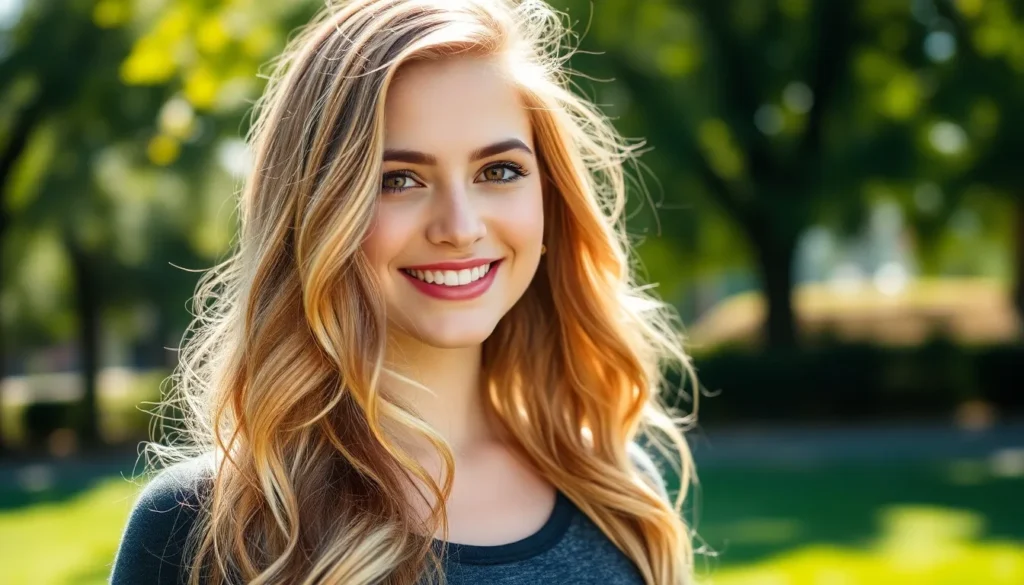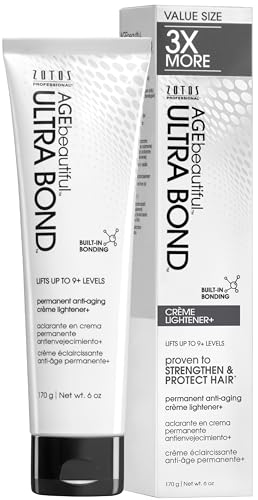Blonde highlights can transform your look from ordinary to absolutely stunning in just one salon visit. Whether you’re looking to brighten your natural color or add dimension to flat hair, strategic blonde placement creates that sun-kissed glow we all crave.
We’ve all seen celebrities rock those perfect blonde highlights that seem effortlessly chic. The secret isn’t just in choosing the right shade – it’s understanding which highlighting technique works best for your hair type, face shape, and lifestyle. From subtle babylights to bold chunky streaks, there’s a blonde highlighting method that’ll complement your unique style.
The best part? Blonde highlights offer incredible versatility. You can go as subtle or as dramatic as you want, and they work beautifully on virtually every base color. Let’s jump into everything you need to know about achieving those gorgeous blonde highlights that’ll have everyone asking for your colorist’s number.
Understanding the Different Types of Blonde Highlights
Each blonde highlighting technique offers unique benefits and creates distinctly different looks. We’ll explore the most popular methods to help you choose the perfect approach for your hair transformation.
Traditional Foil Highlights
Traditional foil highlights remain the most precise method for creating consistent blonde streaks throughout your hair. We use aluminum foils to separate sections of hair before applying bleach or lightener, allowing for maximum control over placement and saturation. This technique works exceptionally well for creating dramatic contrast and achieving multiple shades of blonde in a single session.
Foil highlights typically take 2 to 4 hours to complete depending on your hair length and desired lightness level. We can customize the thickness of each highlight from thin pencil streaks to broader sections for more coverage. This method provides the most predictable results and allows us to achieve the lightest blonde shades possible.
Balayage Technique
Balayage creates natural looking blonde highlights by hand painting lightener directly onto your hair without using foils. We strategically place highlights where the sun would naturally lighten your hair, focusing on the mid lengths and ends while leaving the roots darker. This French technique produces a soft, graduated color that grows out beautifully without harsh regrowth lines.
The balayage process typically requires less maintenance than traditional highlights, with touch ups needed every 3 to 4 months instead of every 6 to 8 weeks. We can create subtle sun kissed effects or more dramatic contrasts depending on your preferences. This method works particularly well on wavy and curly hair textures where the organic placement enhances natural movement.
Babylights Method
Babylights involve applying extremely fine blonde highlights that mimic the natural hair color variations found in children’s hair. We use ultra thin sections no wider than a few millimeters to create subtle dimension and movement throughout your hair. This technique requires exceptional precision and often takes 3 to 5 hours to complete.
The babylights method produces the most natural looking blonde highlights available today. We strategically place dozens of micro fine highlights to add brightness without creating obvious streaks or chunks. This approach works beautifully on all hair colors and provides a sophisticated, expensive looking finish that enhances your natural beauty.
Chunky Highlights
Chunky highlights feature bold, thick sections of blonde that create dramatic contrast against your base color. We typically use sections that range from half an inch to two inches wide, creating a statement look that stands out immediately. This 1990s inspired technique has made a strong comeback with modern updates and improved color formulations.
These substantial blonde sections work best on medium to thick hair textures that can support the bold contrast. We often combine chunky highlights with face framing pieces to create a cohesive look that enhances your facial features. This method requires regular maintenance every 6 to 8 weeks to keep the contrast sharp and prevent brassiness.
Choosing the Right Blonde Shade for Your Skin Tone
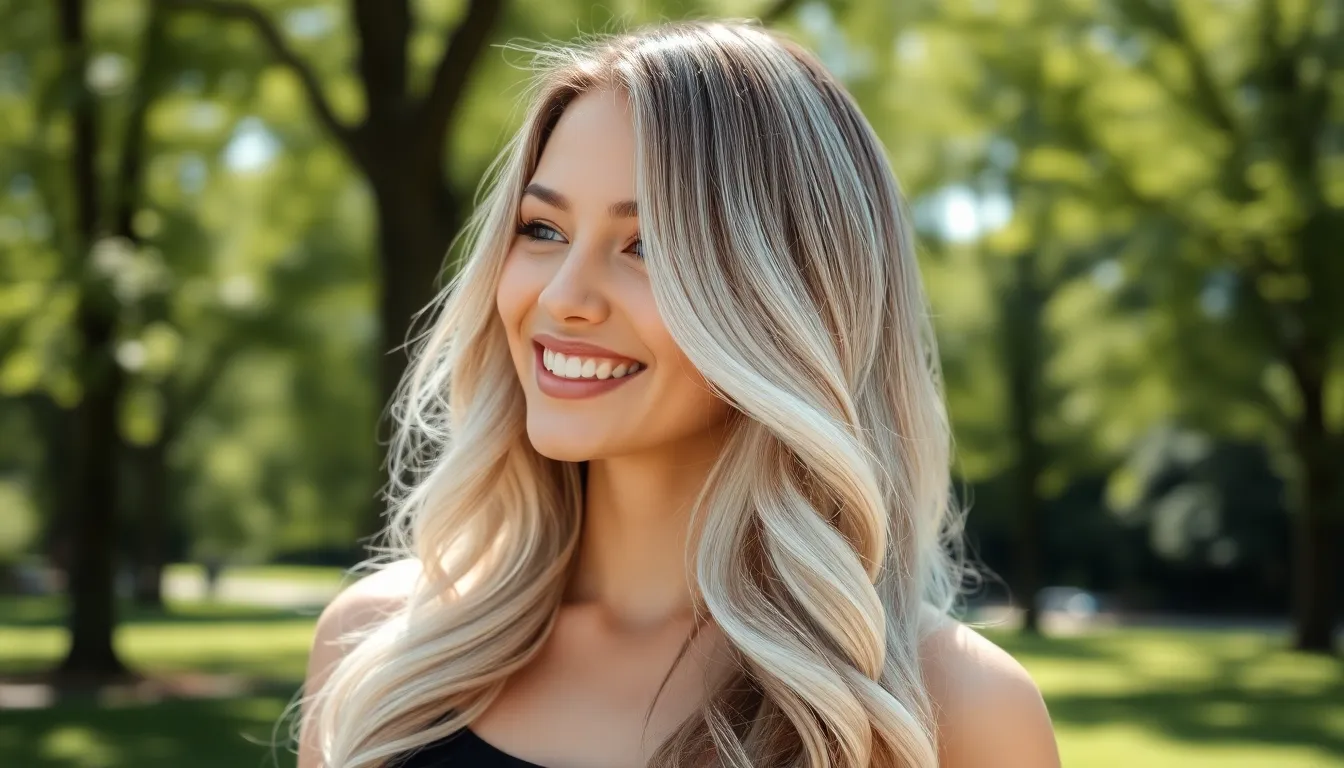
Understanding your skin’s undertones makes all the difference when selecting blonde highlights that’ll enhance your natural beauty. We’ll explore how different blonde shades complement various skin tones to help you achieve the most flattering results.
Cool-Toned Blonde Highlights
Platinum blonde highlights work beautifully on cool skin tones with pink, red, or blue undertones. These icy shades create stunning contrast without competing with your natural coloring. Ashy blonde tones eliminate any unwanted warmth that might clash with cool undertones. Silver blonde highlights add dimension while maintaining the cool color palette that flatters your complexion. Champagne blonde offers a softer alternative that still complements cool skin without being too stark. We recommend these shades if you have fair skin that burns easily or olive complexions with cool undertones.
Warm-Toned Blonde Highlights
Golden blonde highlights enhance warm skin tones with yellow, peach, or golden undertones perfectly. Honey blonde shades create rich dimension that complements the natural warmth in your skin. Caramel highlights add depth while working harmoniously with warm complexions. Butterscotch blonde tones provide gorgeous contrast for medium to dark skin with warm undertones. Strawberry blonde highlights offer a unique option that bridges warm blonde and red tones. These shades work best if you tan easily or have naturally warm undertones in your skin.
Neutral Blonde Options
Beige blonde highlights suit neutral skin tones that don’t lean heavily warm or cool. Sandy blonde shades provide versatile options that work with most complexions. Vanilla blonde creates soft dimension without pulling too warm or too cool. Mushroom blonde offers modern sophistication for those wanting subtle enhancement. Dirty blonde highlights add natural looking variation that complements balanced skin tones. We suggest these options if you’re unsure of your undertones or want flexibility to change your makeup colors without worrying about clashing with your highlights.
Preparing Your Hair for Blonde Highlights
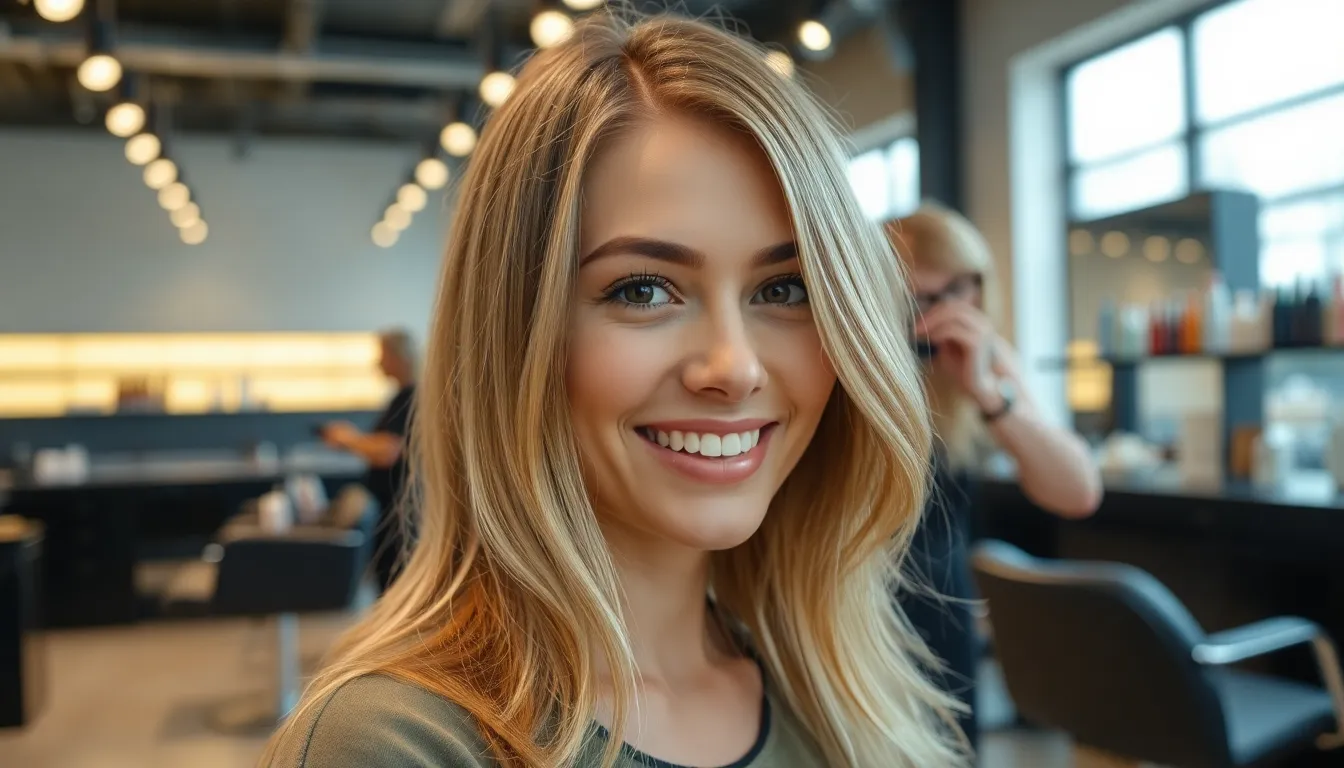
Proper preparation sets the foundation for stunning blonde highlights that look natural and remain healthy. Taking the right steps before your appointment ensures optimal color results and minimizes potential damage.
Assessing Your Current Hair Condition
Evaluating your hair’s current state helps determine the best highlighting approach for your unique situation. We recommend examining several key factors before scheduling your blonde highlight appointment.
Porosity levels affect how your hair absorbs and holds color. Perform a simple strand test by placing a clean hair in water – if it sinks quickly, your hair has high porosity and may grab color faster than expected.
Chemical history plays a crucial role in blonde highlight success. Previous coloring, perming, or relaxing treatments can create uneven results or cause excessive damage during the lightening process.
Natural texture and thickness influence which highlighting techniques work best. Fine hair typically requires gentler processing times, while thick or coarse hair may need stronger developers to achieve desired lightness levels.
Elasticity testing reveals your hair’s strength and flexibility. Stretch a wet strand gently – healthy hair should return to its original length without breaking immediately.
Pre-Treatment Requirements
Starting a pre-treatment routine 2-4 weeks before your appointment strengthens your hair for the highlighting process. We suggest implementing these essential steps to optimize your results.
Deep conditioning treatments should become part of your weekly routine leading up to your appointment. Use protein-rich masks twice weekly to rebuild damaged cuticles and improve overall hair integrity.
Clarifying shampoo removes product buildup that can interfere with color processing. Apply once weekly to eliminate styling residue, oils, and mineral deposits that create barriers to even color application.
Heat styling reduction prevents additional damage before chemical processing begins. Limit blow drying, flat ironing, and curling to special occasions only during your preparation period.
Trimming split ends 1-2 weeks before highlighting removes damaged portions that could worsen during chemical processing. Fresh cuts also help highlights blend more seamlessly with your natural hair texture.
Consultation with a Professional Colorist
Scheduling a thorough consultation ensures your blonde highlights match your vision while maintaining hair health. We recommend discussing these critical elements during your pre-appointment meeting.
Color goals should be clearly communicated using reference photos from multiple angles. Bring images showing the exact blonde tones, placement patterns, and overall intensity you want to achieve.
Maintenance expectations need realistic discussion about upkeep requirements. Most blonde highlights require touch-ups every 8-12 weeks, with toning treatments every 4-6 weeks to maintain desired shades.
Timeline planning helps set appropriate expectations for dramatic color changes. Multiple sessions may be necessary when lightening dark hair significantly or achieving platinum blonde results safely.
Aftercare recommendations should be established before your appointment begins. Your colorist will suggest exact shampoos, conditioners, and treatments to preserve your new blonde highlights and prevent fading.
Maintaining Your Blonde Highlights at Home
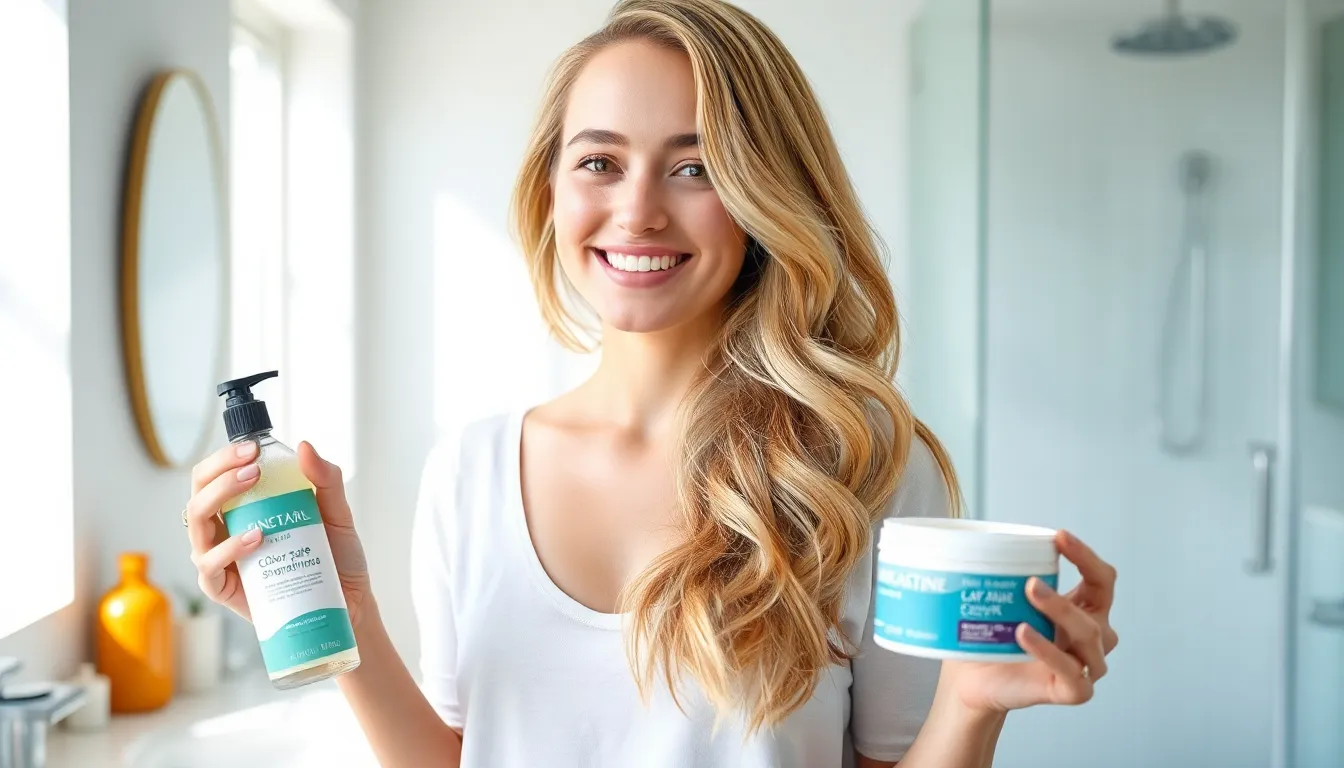
Proper maintenance keeps your blonde highlights vibrant and prevents damage between salon visits. We’ll help you establish an effective home care routine that preserves your color investment.
Essential Hair Care Products
Color-safe shampoo and conditioner form the foundation of your blonde highlight maintenance routine. These products contain gentle cleansing agents that won’t strip your highlights while maintaining moisture levels. Look for sulfate-free formulas specifically designed for color-treated hair.
Heat protectant spray shields your highlights from damage during styling sessions. Apply this product before using blow dryers, curling irons, or flat irons to prevent color fading and hair breakage. Choose products with UV protection to guard against sun damage.
Leave-in conditioner provides ongoing moisture and protection throughout the day. These lightweight formulas smooth your hair cuticles and reduce frizz without weighing down your highlights. Apply to damp hair before styling for best results.
Hair masks deliver intensive repair and hydration for highlighted hair. Use protein-based masks once monthly to strengthen damaged strands and moisture-rich masks weekly to combat dryness. Alternate between these treatments based on your hair’s exact needs.
Weekly Deep Conditioning Treatments
Schedule deep conditioning sessions every seven days to maintain your highlights’ health and vibrancy. These treatments penetrate deeper than regular conditioners to repair damage from the highlighting process. Apply the mask from mid-length to ends, avoiding your scalp area.
Choose treatment timing based on your wash schedule for maximum effectiveness. Apply deep conditioning masks on freshly shampooed, towel-dried hair when your cuticles are open and ready to absorb nutrients. Leave treatments on for 10-15 minutes as directed.
Focus application areas where your highlights are most concentrated for targeted care. These sections typically need extra attention since they’ve undergone more chemical processing. Distribute the product evenly using a wide-tooth comb to ensure complete coverage.
Rinse thoroughly with cool water to seal your hair cuticles and lock in the treatment benefits. Cool water helps preserve your highlight color while adding shine to your finished look. Follow up with a light leave-in conditioner if needed.
Purple Shampoo Usage
Use purple shampoo once or twice weekly to neutralize yellow and brassy tones in your blonde highlights. This color-correcting product contains violet pigments that counteract unwanted warm tones. Start with once-weekly applications to assess your hair’s response.
Apply strategically to areas where brassiness appears most prominent in your highlights. Focus on your mid-lengths and ends where highlights tend to show the most color shift. Leave the product on for 2-3 minutes during your first few uses.
Monitor color results closely to avoid over-toning your highlights to an ashy or grayish shade. Reduce frequency if your highlights become too cool-toned or increase usage if brassiness persists. Every hair type responds differently to purple shampoo.
Follow manufacturer instructions for optimal results and to prevent damage from overuse. Some purple shampoos are more pigmented than others, requiring shorter processing times. Always condition after purple shampoo use to maintain moisture levels.
Avoiding Common Blonde Highlight Mistakes
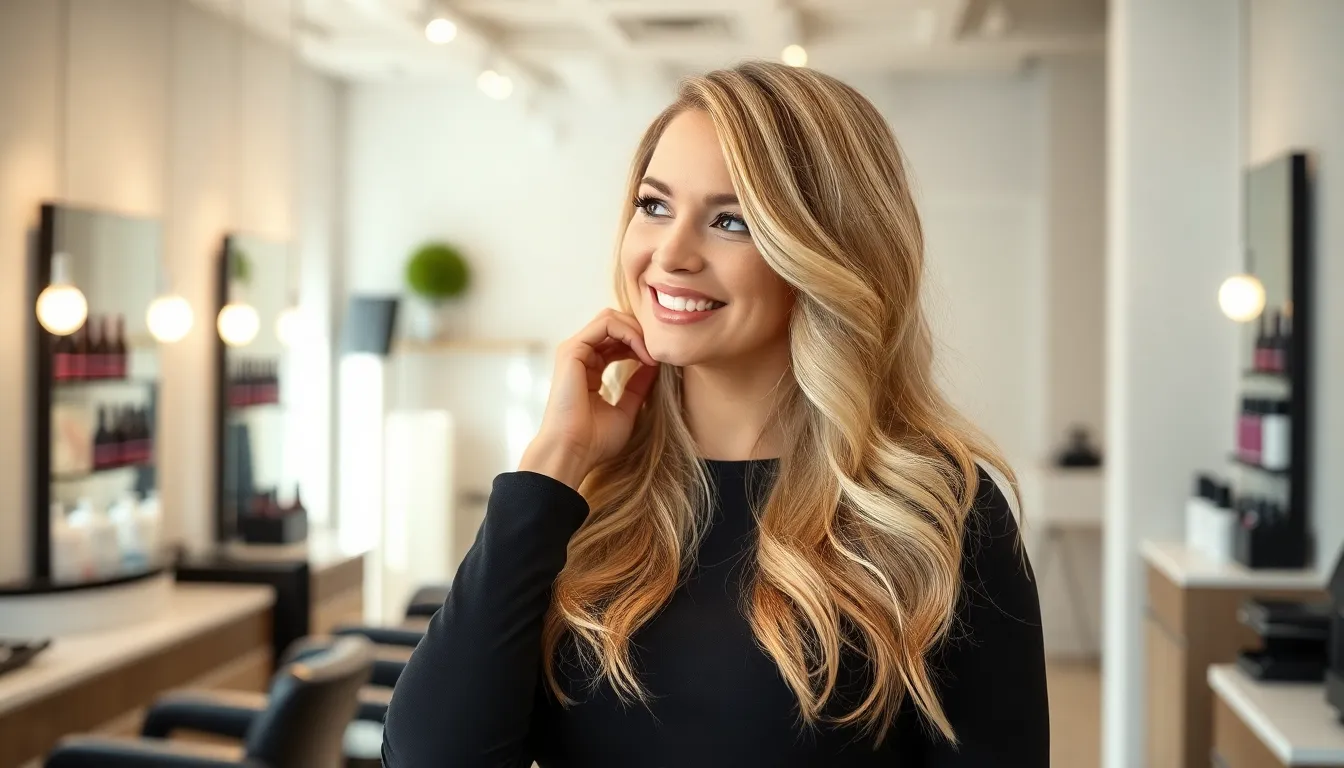
We’ve seen countless clients struggle with blonde highlight mishaps that could have been easily prevented. Learning from these common pitfalls ensures your highlighting journey leads to stunning results instead of hair disasters.
Over-Processing Damage
Over-processing stands as the most devastating mistake we encounter with blonde highlights. This occurs when hair undergoes too much chemical processing in a single session or doesn’t receive adequate recovery time between treatments.
Damaged hair shows several telltale signs we always watch for:
- Excessive dryness that makes hair feel brittle and straw-like to the touch
- Breakage patterns along the mid-shaft where bleach was applied most heavily
- Elasticity loss causing hair to snap instead of bouncing back when stretched
- Porosity changes resulting in uneven color absorption and fading
Preventing over-processing requires patience and professional expertise. We recommend spacing highlight sessions at least 8-12 weeks apart to allow hair cuticles proper healing time. Multiple gentle lifting sessions work better than attempting dramatic color changes in one appointment.
Hair’s natural strength determines how much processing it can handle. Virgin hair typically tolerates more aggressive treatments than previously colored or chemically treated strands. We always perform strand tests before full applications to assess lifting potential safely.
Wrong Shade Selection
Choosing incompatible blonde shades creates harsh contrasts that look unnatural against your skin tone. This mistake happens when clients select highlights based on trends rather than what complements their individual features.
Cool undertones require exact blonde families to achieve harmony. Platinum, ash, and silver highlights enhance cool-toned skin beautifully. Warm golden or honey shades can create unflattering yellow casts on cool complexions.
Warm skin tones flourish with corresponding warm blonde highlights. Golden, caramel, and buttery blonde shades complement warm undertones naturally. Cool ashy tones often appear muddy or gray against warm skin.
Face shape influences highlight placement and intensity choices. Wide placement can broaden round faces unnecessarily. Concentrated highlights around the face can overwhelm petite features.
We recommend testing potential shades with temporary color or extensions first. This preview method prevents permanent regrets and helps visualize how different blondes interact with your natural coloring.
Inadequate Aftercare
Skipping proper aftercare routines destroys even expertly applied blonde highlights within weeks. This neglect leads to premature fading, brassiness, and unnecessary damage that could have been prevented.
Regular washing with standard shampoo strips blonde highlights rapidly. Color-safe formulas preserve highlight integrity by using gentler cleansing agents. We suggest washing every 2-3 days maximum to extend color longevity.
Heat styling without protection causes immediate highlight degradation. Thermal damage compounds chemical processing effects, creating double the hair stress. Always apply heat protectant sprays before using styling tools above 300°F.
Purple shampoo misuse creates common toning disasters. Over-toning turns highlights gray or purple instead of neutralizing brassiness. We recommend using purple shampoo once weekly for maintenance, increasing frequency only if yellow tones appear.
Deep conditioning treatments become essential after highlighting appointments. Weekly protein and moisture masks restore hair’s chemical balance. Skipping these treatments leads to progressive weakness and breakage over time.
UV exposure fades blonde highlights faster than any other factor. Sun protection through leave-in treatments or hats preserves color investment significantly. Summer months require extra vigilance to maintain highlight vibrancy.
Styling Tips for Blonde Highlights
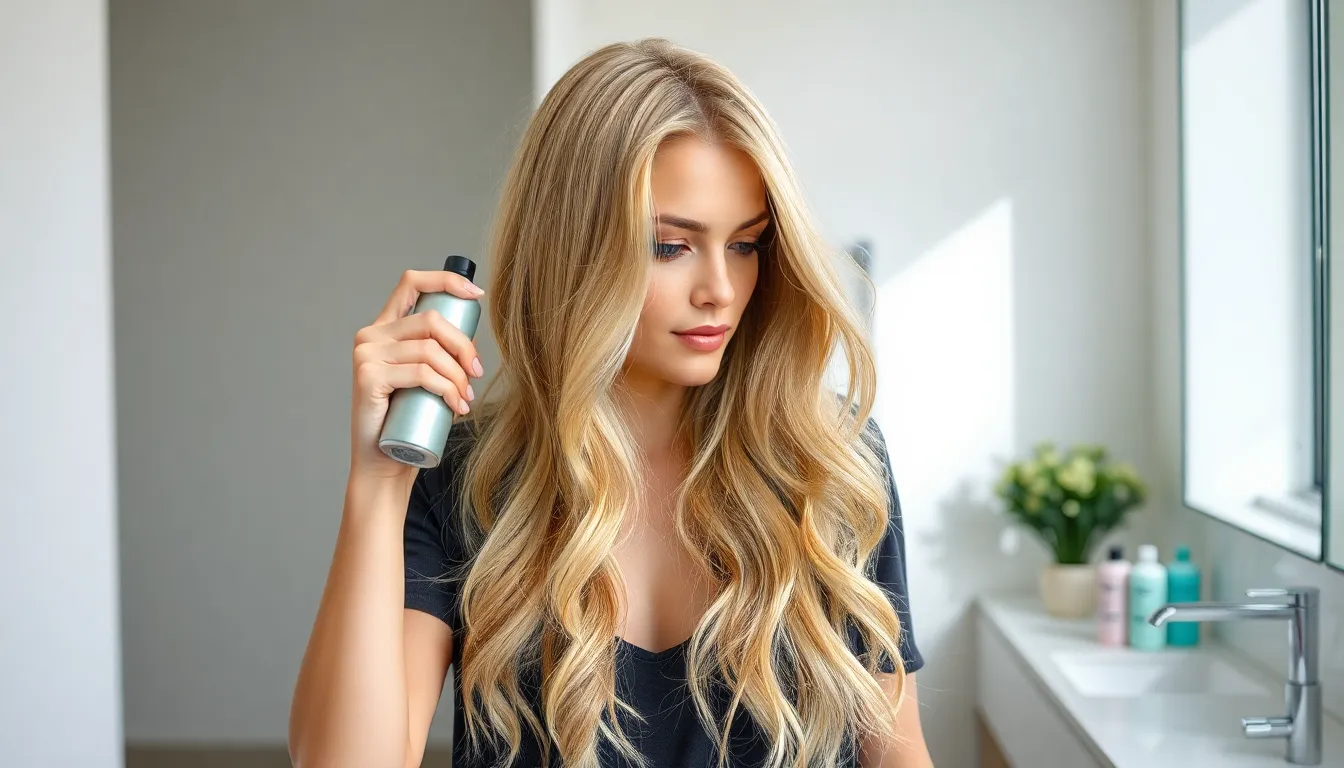
Styling blonde highlights requires exact techniques and products to showcase their beauty while protecting your investment. We’ve compiled expert methods to help you maximize your highlights’ impact and longevity.
Heat Protection Methods
Pre-styling preparation forms the foundation of heat protection for blonde highlights. We recommend applying a heat protectant spray to damp hair before using any thermal tools, creating a barrier that shields your delicate lightened strands from temperatures up to 450°F.
Temperature control prevents unnecessary damage to your highlighted sections. Start with lower heat settings around 250-300°F for fine hair or 300-350°F for thicker textures, gradually increasing only if needed for your desired style.
Sectioning techniques ensure even heat distribution across your highlights. Divide your hair into 1-2 inch sections, focusing extra attention on heavily highlighted areas that require gentler handling due to increased porosity.
Tool selection makes a important difference in protecting blonde highlights from heat damage. Ceramic or tourmaline styling tools distribute heat more evenly than traditional options, while ionic technology reduces static and frizz common in lightened hair.
Improving Highlight Visibility
Strategic parting instantly amplifies the appearance of your blonde highlights throughout your hairstyle. Change your part from its usual position to reveal hidden highlighted sections, creating the illusion of more extensive color work.
Texturizing sprays add dimension that makes highlights pop against your base color. Apply sea salt spray or texturizing mist to damp hair before styling to create separation between strands and showcase individual highlighted pieces.
Layered styling maximizes highlight visibility by creating movement and depth in your hair. Use a round brush while blow-drying to lift sections and create volume that allows light to catch your blonde pieces from multiple angles.
Braiding techniques offer creative ways to display your highlights while protecting them from environmental damage. Try loose side braids, crown braids, or fishtail styles that weave highlighted and natural sections together for striking contrast.
Product Recommendations for Blonde Hair
Color-protecting shampoos specifically formulated for blonde hair maintain your highlights’ vibrancy while cleansing gently. We suggest sulfate-free options like Redken Color Extend Blondage or Olaplex No. 4 Shampoo for optimal color preservation.
Purple toning products neutralize unwanted yellow and brassy tones that develop in blonde highlights over time. Use purple shampoo 1-2 times weekly, leaving it on for 2-3 minutes before rinsing to maintain cool-toned highlights.
| Product Type | Recommended Brands | Usage Frequency |
|---|---|---|
| Color-Safe Shampoo | Redken, Olaplex, Matrix | 2-3 times weekly |
| Purple Shampoo | Fanola, Schwarzkopf, Clairol | 1-2 times weekly |
| Deep Conditioner | Kerastase, Moroccanoil, Aussie | Once weekly |
| Heat Protectant | TRESemmé, CHI, Kenra | Before every heat styling |
Leave-in treatments provide ongoing nourishment for highlighted hair between washes. Apply lightweight oils like argan or coconut oil to mid-lengths and ends, avoiding the roots to prevent weighing down your style.
Styling creams designed for color-treated hair offer hold and protection simultaneously. Choose products with UV filters to shield your highlights from sun damage that can cause fading and dryness.
Professional vs. DIY Blonde Highlights

Choosing between professional salon services and at-home highlighting kits can significantly impact your final results and hair health. We’ll explore the key differences to help you make an well-informed choice for your blonde transformation.
Benefits of Salon Treatment
Professional colorists possess extensive training in color theory and chemical processes that DIY enthusiasts typically lack. Their expertise allows them to assess your hair’s porosity, existing color, and damage level before selecting appropriate bleaching agents and toners.
Customized color formulation represents one of the biggest advantages of salon treatments. Professional colorists can mix multiple shades to create your perfect blonde tone while considering your skin undertones and lifestyle preferences.
Advanced application techniques like precise foil placement, strategic sectioning, and proper timing ensure even color distribution throughout your hair. Salon professionals use high-quality products that often aren’t available for consumer purchase.
Damage prevention becomes crucial when lightening hair multiple levels. Professional colorists monitor the bleaching process closely and can adjust timing or strength to minimize breakage and chemical burns.
Immediate problem solving allows professionals to address unexpected results during the highlighting process. They can neutralize unwanted tones, adjust placement, or modify the formula if your hair reacts differently than anticipated.
At-Home Highlighting Kits
Convenience factors make DIY highlighting kits appealing for many people seeking blonde highlights. You can apply them on your own schedule without booking salon appointments or traveling to a professional facility.
Basic highlighting kits typically include bleaching powder, developer, applicator tools, and sometimes toning products. These consumer-grade products are formulated to be safer but less powerful than professional formulations.
Application challenges often arise when trying to section and highlight your own hair evenly. Reaching the back sections and maintaining consistent spacing between highlights proves difficult without professional assistance.
Limited shade customization restricts your options compared to professional treatments. Most box kits offer only a few predetermined shade options that may not complement your exact skin tone or hair color.
Potential risks increase when using chemical lightening products without professional knowledge. Over-processing, uneven results, and hair damage can occur if you misunderstand timing or application techniques.
Cost Comparison Analysis
| Treatment Type | Initial Cost | Touch-up Frequency | Annual Cost |
|---|---|---|---|
| Professional Highlights | $150-$400 | Every 8-12 weeks | $600-$1,600 |
| DIY Highlighting Kits | $15-$35 | Every 6-8 weeks | $120-$280 |
| Salon Root Touch-ups | $75-$150 | Every 6-8 weeks | $400-$975 |
| Color Correction (if needed) | $200-$500 | As required | Variable |
Upfront investment for professional highlights costs significantly more than DIY kits initially. But, salon results typically last longer and require fewer touch-up sessions throughout the year.
Hidden costs associated with DIY highlighting can accumulate quickly. Failed attempts often require professional color correction services that cost more than the original salon treatment would have.
Time investment varies considerably between options. DIY kits require 2-4 hours of your time plus preparation and cleanup, while salon appointments typically take 2-3 hours with professional handling of all processes.
Long-term value often favors professional treatments even though higher initial costs. Quality salon highlights maintain their appearance longer and cause less damage, reducing the need for expensive corrective treatments or hair repair products.
Refreshing and Touch-Up Techniques
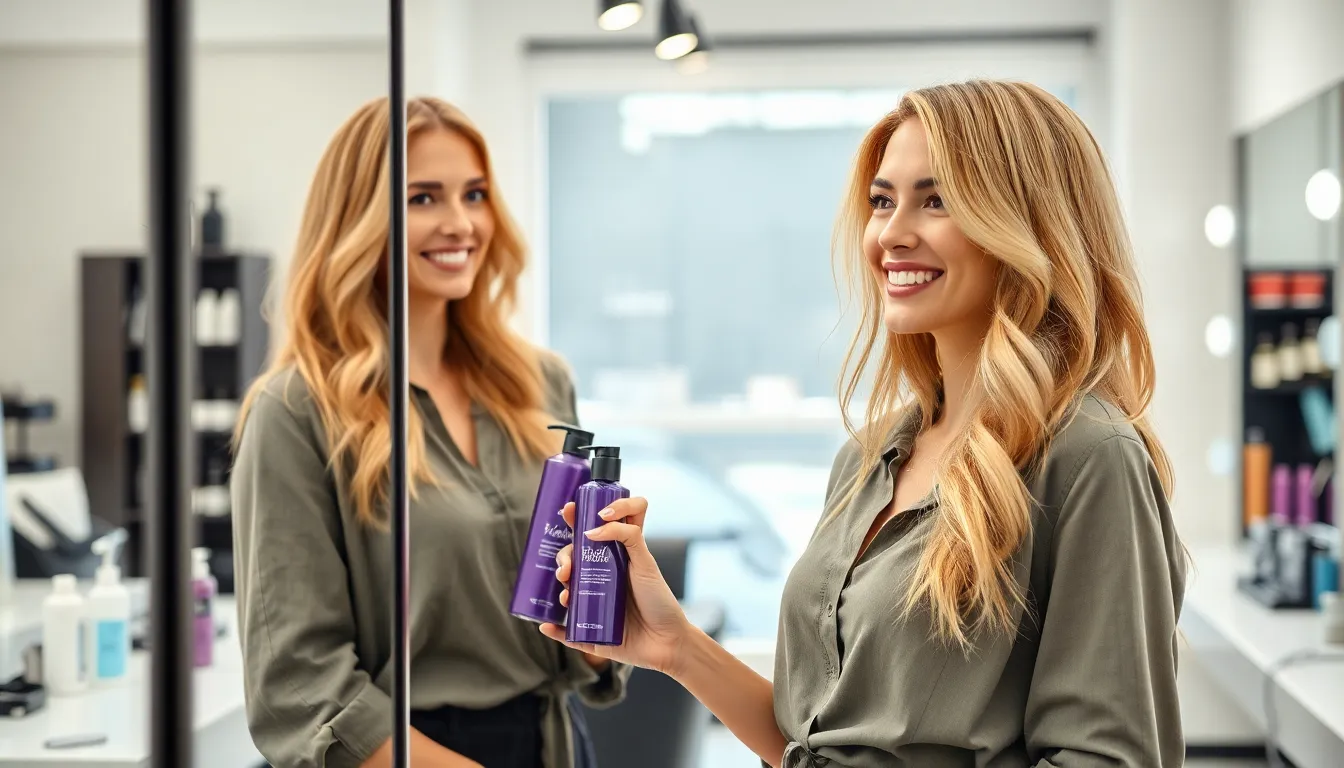
Maintaining vibrant blonde highlights requires strategic refresh techniques to keep your color looking salon fresh. We’ll explore essential timing guidelines and application methods that preserve your highlight investment.
Root Touch-Up Timeline
Six to eight weeks marks the standard timeline for professional root touch-ups with blonde highlights. Natural hair growth becomes noticeable at this point, creating a visible contrast between your highlighted sections and darker roots.
Four weeks represents the minimum timeframe for touch-ups if you have fast-growing hair or prefer a consistently polished appearance. Waiting longer than this period helps maintain hair health by reducing chemical processing frequency.
Ten to twelve weeks works for those with slower hair growth or subtle highlighting techniques like babylights. This extended timeline allows natural regrowth to blend more seamlessly with existing highlights.
Personal hair growth rate varies significantly between individuals, with some people experiencing half an inch of growth monthly while others see less. Tracking your exact growth pattern helps establish a personalized touch-up schedule that maximizes color longevity.
Toner Application Methods
Gloss treatments refresh blonde highlights by adding shine and neutralizing unwanted brassiness between salon visits. Professional colorists apply these semi-permanent formulas directly to highlighted sections for 10-20 minutes.
Purple shampoo masks provide at-home toning answers that counteract yellow tones in blonde highlights. We recommend using these treatments once or twice weekly, leaving the product on damp hair for 3-5 minutes before rinsing.
Foam toners offer precise application for targeting exact highlighted sections that need color correction. These lightweight formulas distribute evenly through hair strands without weighing down fine textures.
Spray toners deliver quick touch-up answers for maintaining color between appointments. Professional-grade spray formulas can be applied to dry hair, providing instant color refreshing without requiring a full salon visit.
Seasonal Color Adjustments
Summer highlighting typically involves adding brighter, more golden tones to complement sun-kissed skin and outdoor lifestyle activities. Natural sunlight exposure can lighten existing highlights, making maintenance touch-ups less frequent during warmer months.
Winter color transitions often shift toward cooler blonde tones like platinum or ashy shades that complement indoor lighting and deeper seasonal fashion colors. These adjustments help your highlights appear more flattering against winter skin tones.
Spring refresh appointments focus on removing any brassiness that developed during winter months while adding dimension with new highlight placement. This seasonal update prepares your hair color for increased sun exposure and humidity changes.
Fall adjustments incorporate slightly deeper blonde tones that harmonize with autumn colors and indoor heating environments. Strategic lowlight additions during this season create depth and richness that complements the changing light conditions.
Conclusion
Blonde highlights remain one of the most effective ways to transform your look and add dimension to your hair. We’ve covered everything from choosing the right shade for your skin tone to mastering maintenance routines that keep your highlights looking salon-fresh.
Whether you opt for professional services or decide to try DIY kits the key lies in understanding your hair’s unique needs and committing to proper aftercare. Remember that quality highlights are an investment in your appearance that requires ongoing attention.
With the right approach to touch-ups seasonal adjustments and daily maintenance your blonde highlights will continue to enhance your natural beauty for months to come. Take your time make informed decisions and don’t hesitate to consult with professionals when needed.
Frequently Asked Questions
What are the different types of blonde highlighting techniques?
The main blonde highlighting techniques include traditional foil highlights for dramatic contrast, balayage for natural-looking results with less maintenance, babylights that mimic natural color variations, and chunky highlights for bold, thick sections. Each technique offers unique benefits and can be tailored to create subtle or dramatic looks depending on your preferences.
How do I choose the right blonde shade for my skin tone?
Your skin’s undertones determine the best blonde shade. Cool-toned skin suits platinum and ashy blonde shades, while warm-toned skin looks best with golden and honey highlights. If you have neutral undertones, versatile shades like beige or sandy blonde work well. A professional colorist can help assess your undertones accurately.
How often should I touch up my blonde highlights?
Most people need root touch-ups every six to eight weeks, though this varies based on individual hair growth rates and desired maintenance level. Faster hair growth may require more frequent touch-ups, while slower growth can extend the time between appointments. Your colorist can recommend a personalized timeline.
Should I get blonde highlights at a salon or use DIY kits?
Professional salon treatments offer expert color formulation, advanced techniques, and damage prevention, resulting in longer-lasting, more even results. DIY kits provide convenience and lower upfront costs but carry risks like uneven application and limited shade options. For best results, especially for dramatic changes, professional treatment is recommended.
How do I maintain blonde highlights at home?
Use sulfate-free shampoos and deep conditioning treatments regularly. Purple shampoo helps neutralize brassy tones and should be used once or twice weekly. Protect hair from heat damage with styling products, and schedule regular toner applications to keep your blonde looking fresh and vibrant.
Can blonde highlights damage my hair?
When done professionally and with proper preparation, blonde highlights cause minimal damage. However, the bleaching process can weaken hair structure. Pre-treatment with bond builders, proper aftercare with moisturizing products, and avoiding over-processing help minimize potential damage and maintain hair health.
How much do professional blonde highlights typically cost?
Professional blonde highlights typically cost more upfront than DIY options, but they often provide better long-term value through longer-lasting results and fewer required touch-ups. Costs vary by location, salon, and technique complexity. Consult with local salons for accurate pricing in your area.
Should I adjust my blonde highlights seasonally?
Yes, seasonal adjustments can enhance your look year-round. Summer calls for brighter, golden tones, while winter may favor cooler shades. Spring appointments focus on removing brassiness accumulated over winter, and fall adjustments can incorporate deeper tones to complement the changing season and your wardrobe.

